Thumb Ulnar Collateral Ligament Tear is one of the most common injuries affecting the thumb, often caused by a fall or sudden forceful motion that bends the thumb backward. At Tran Plastic Surgery in Huntington Beach, CA, we specialize in advanced diagnosis and treatment both surgical and non-surgical to restore strength, stability, and function to the hand.
Understanding Thumb Ulnar Collateral Ligament (UCL) Tear
The ulnar collateral ligament (UCL) is a strong band of connective tissue that stabilizes the base of the thumb at the metacarpophalangeal (MCP) joint. When this ligament is overstretched or torn, patients experience pain, swelling, and loss of thumb stability. This condition is sometimes referred to as “Skier’s Thumb” or “Gamekeeper’s Thumb,” because it frequently affects athletes and active individuals.
A torn UCL not only limits hand function but, if left untreated, can lead to chronic instability, weakness, and early arthritis in the thumb joint. Early evaluation by a hand surgery specialist is crucial to achieving the best possible recovery.
Causes of Thumb UCL Tear
While anyone can sustain a UCL tear, certain activities increase the risk:
-
Falls onto an outstretched hand – the most common cause.
-
Skiing injuries – when a ski pole strap forces the thumb back during a fall.
-
Ball sports (football, baseball, basketball) – where catching or deflecting a ball places sudden stress on the thumb.
-
Workplace or household accidents – sudden thumb hyperextension during daily activities.
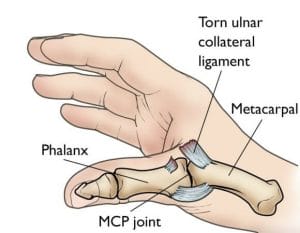
Fig. 1: Illustration of a completely torn ulnar collateral ligament.
Symptoms to Watch For
The severity of a UCL injury ranges from a mild sprain to a complete ligament rupture. Typical symptoms include:
-
Pain and tenderness at the base of the thumb
-
Swelling and bruising around the MCP joint
-
A noticeable lump if the ligament retracts
-
Difficulty pinching or gripping objects
-
A feeling of looseness or instability in the thumb joint
If symptoms persist beyond 48 hours, it’s important to seek medical care to avoid long-term complications.
Types of Thumb UCL Injuries
Thumb sprains are classified into three grades:
-
Grade 1 – Mild Sprain: Ligament is stretched but intact.
-
Grade 2 – Moderate Sprain: Partial tear with some loss of function.
-
Grade 3 – Severe Sprain: Complete ligament tear, sometimes with a small bone fragment pulled off (avulsion fracture).
How Thumb UCL Tears Are Diagnosed
A thorough evaluation includes:
-
Physical Examination – assessing pain, swelling, and thumb stability.
-
X-rays – to rule out fractures or avulsion injuries.
-
Stress X-rays – applying gentle force to test MCP joint stability.
-
MRI or Ultrasound – detailed imaging of ligament damage and surrounding soft tissue.
Treatment Options at Tran Plastic Surgery
Treatment depends on the severity of the injury. At Tran Plastic Surgery, our goal is always to preserve thumb function while ensuring lasting stability.
Home Care for Mild Injuries
For Grade 1 sprains:
-
RICE Protocol: Rest, Ice, Compression, Elevation
-
NSAIDs: Over-the-counter medications like ibuprofen for pain and swelling
Nonsurgical Treatments
For moderate (Grade 2) injuries:
-
Immobilization: A custom thumb spica splint or cast for several weeks
-
Activity Modification: Limiting stress to the thumb until ligaments heal
Surgical Treatment
For severe (Grade 3) injuries or cases that fail conservative care:
-
Primary Repair: Reattaching the torn ligament to the bone
-
InternalBrace™ Ligament Augmentation: Using advanced FiberWire technology for strong repair and faster recovery
-
Avulsion Fracture Repair: Using pins, screws, or bone anchors when necessary
After surgery, patients typically wear a cast or splint for 6–12 weeks, followed by hand therapy to restore motion and strength.
Expected Recovery and Outcomes
Most patients recover well with timely treatment. Non-surgical cases heal within 4–6 weeks, while surgical cases require 8–12 weeks of healing and rehabilitation. When properly managed, patients can return to full hand function, sports, and daily activities without instability.
If left untreated, however, a UCL tear can lead to:
-
Chronic pain
-
Persistent thumb weakness
-
Joint arthritis requiring later reconstructive surgery
Why Choose Tran Plastic Surgery?
At Tran Plastic Surgery in Huntington Beach, CA, our practice focuses on Hand Surgery and reconstructive care. Led by Dr. Tuan Tran, a board-certified plastic and hand surgeon, we provide advanced treatments tailored to each patient’s needs.
Our center combines expert surgical skills with compassionate patient care, ensuring that every individual feels supported throughout the healing journey.
We also treat related conditions such as:
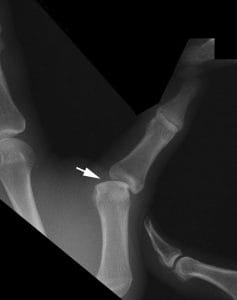 Fig. 2: Stress x-ray showing instability in the MCP joint, an indication that the ulnar collateral ligament is completely torn.
Fig. 2: Stress x-ray showing instability in the MCP joint, an indication that the ulnar collateral ligament is completely torn.
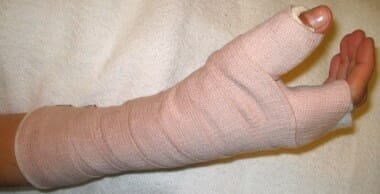 Fig. 3: Thumb spica cast on right arm.
Fig. 3: Thumb spica cast on right arm.
Take the First Step Toward Recovery
If you suspect a Thumb Ulnar Collateral Ligament Tear, don’t delay treatment. Early evaluation ensures the best chance of full recovery and long-term thumb stability.
📞 Call us today at 714-839-8000 or contact us online to schedule your consultation with Dr. Tuan Tran at Tran Plastic Surgery in Huntington Beach, CA.
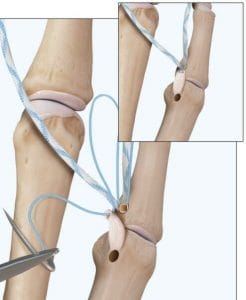
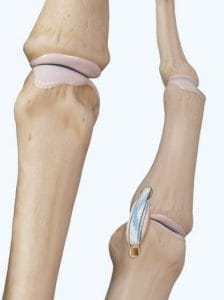 Fig. 4: Thumb Ulnar Collateral Ligament repair with InternalBrace Ligament Augmentation.
Fig. 4: Thumb Ulnar Collateral Ligament repair with InternalBrace Ligament Augmentation.
Frequently Asked Questions
1. Can a thumb UCL tear heal without surgery?
Yes, mild sprains and partial tears often heal with splinting and rest. Complete tears usually require surgical repair.
2. How do I know if I need surgery?
If your thumb feels unstable, weak, or shows no improvement after immobilization, surgery may be recommended.
3. Will I regain full thumb strength after treatment?
With proper care and rehabilitation, most patients regain near-full strength and mobility.
4. How long before I can return to sports?
Athletes typically return to play within 2–3 months, depending on the severity of the injury and type of repair.
*References:
✍️ Arthrex. (20180). Thumb UCL Repair with InternalBrace Ligament Augmentation: Surgical Technique. Retrieved from https://m.arthrex.com/resources/surgical-technique-guide/8IXwzkZmS0-ORwFWNzzj8w/thumb-ucl-repair-with-internalbrace-ligament-augmentation
✍️ Leversedge, F. & Jennings, C. (2018). Distal radius fractures: Broken wrist. OrthoInfo. Retried from https://orthoinfo.aaos.org/en/diseases–conditions/distal-radius-fractures-broken-wrist/
✍️ TR Johnson, LS Steinbach (eds.): Essentials of Musculoskeletal Imaging. Rosemont, IL. American Academy of Orthopaedic Surgeons, 2004, p. 378.

